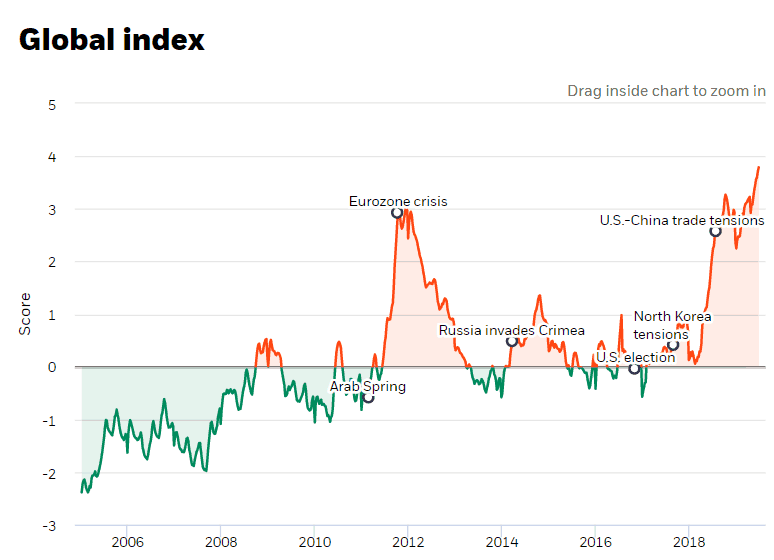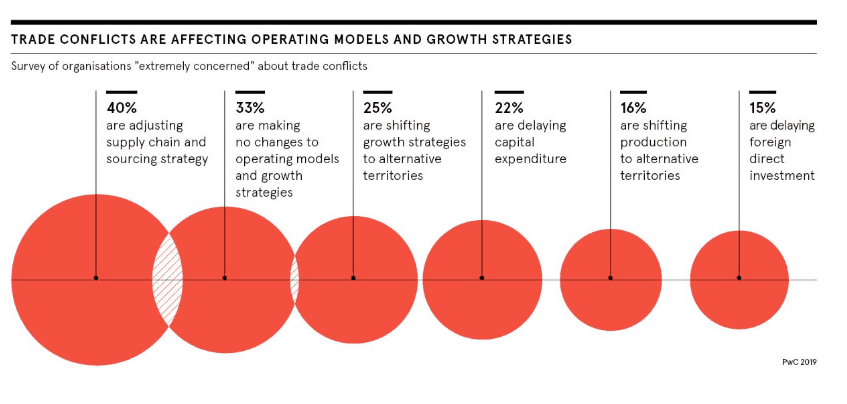
The trade relationship between the United States and China – the world’s two largest economies – is breaking down. Iran is threatening the Strait of Hormuz, through which 40 percent of the world’s oil flows. Weak states in Latin America and the Middle East are failing their citizens, driving migration and ratcheting up tension at borders.
Geopolitical risk is back, and companies with global supply chains are forced to consider the impact that economic, ideological and military conflict between states may have on their operations.
Now more than ever, it is vital for organizations to leverage technology to map out their supply chains, understand their exposure and pivot away from risk and toward new opportunities.
BlackRock’s global index for geopolitical risk is at a 15-year high on U.S.-China competition, Persian Gulf tensions, European fragmentation and South Asia tensions.

“We see geopolitical risk as a material market factor in 2019, especially in an environment of slowing growth and elevated uncertainty about the economic and corporate earnings outlook,” BlackRock wrote in its June report. “At the center of the geopolitical debate? Increasing rivalry between the U.S. and China across economic, ideological and military dimensions.”
FedEx (NYSE: FDX) is one company that’s been caught up in the flux of geopolitics and new competitors. Last week, the parcel carrier sued the U.S. Department of Commerce over fines it had incurred from shipments to Chinese technology firm Huawei. The U.S. government’s export control regulations ban American companies from selling certain kinds of technology to Huawei, but the rules are confusing and increasing FedEx’s costs of compliance. In a separate issue, FedEx announced that its Express unit – which includes air cargo and next-day shipping and accounts for about 45 percent of FedEx revenue – would stop doing business with Amazon.
In a reversal, on July 1 President Trump abruptly lifted the ban on U.S. companies selling to Huawei – for now.
The Transpacific trade lane connecting Asia to the Americas is being reshaped by the United States-China trade dispute and the free trade agreement signed between Asia Pacific countries and Mexico and Canada (the United States declined to join the Trans-Pacific Partnership). Chinese exports to the U.S. are falling off a cliff, while exports from Vietnam, South Korea and Taiwan are experiencing accelerating growth.
Supply chain participants exposed to that conflict and others – President Trump has threatened tariffs at various times against the European Union, Canada, Mexico and even Vietnam most recently – have decisions to make about how to react.
PricewaterhouseCoopers surveyed organizations that reported being “extremely concerned” about trade conflicts, and found that 40 percent were adjusting supply chain and sourcing strategies, 25 percent were shifting growth strategies to alternative territories and 22 percent were delaying capital expenditures.

Just as significantly, one-third of the companies surveyed said they were making no changes to operating models or growth strategies despite being “extremely concerned.” While reasons for the lack of response were not provided, it’s reasonable to infer that companies either don’t have sufficient intelligence into likely trade dispute outcomes, do not fully understand the current risks to their business, or lack the data to decide on an appropriate course of action going forward.
For many companies, harnessing their available, but disparate data, is now more critical than ever. This is where a product offered by Slync comes into play. Slync’s platform, which serves as an integration layer between a company’s internal business functions as well as its supply chain partners, empowers companies to make intelligent, data-driven decisions. Companies can easily calculate costs, transit times and service performance across their supply chains. Instant sharing of relevant data with partners and automated workflow management allows companies to respond to emerging challenges faster than ever.
“Having an integrated view and robust analysis of your network is crucial to making the right adjustments in the face of uncertainty, including geopolitical risk and commercial challenges,” said Chris Kirchner, chief executive officer of Slync. “Slync’s platform gives companies the tools they need to optimize their supply chains to protect value and partnerships while seizing new opportunities.”
Whether a company is shifting its operations, procurement strategy or production facilities in response to geopolitical risk, or whether the company is standing still and letting the world change around it – nothing stays the same. Nothing stays the same, and changes cause cascading effects through complex systems, producing unpredictable results.
Ultimately, in order to navigate geopolitical risk successfully, supply chain companies must leverage technology to orchestrate people, systems, information, processes and capital in an efficient rapid-response.
Just because geopolitical risk – a trade negotiation gone wrong or a cyber-security threat that shuts down a port – keeps you up at night does not mean that your customers should have to worry about it or even be aware of it.
Slync’s integration layer helps companies flex and optimize their supply chains in terms of carried inventory levels, lead times for shipments, availability of suppliers and transportation capacity in new markets and lanes. With Slync, agile, intelligent supply chains can pivot in real time to changing external conditions, balancing cost, service and sales opportunities.
“The pace of global change is faster and more unpredictable than ever,” Kirchner said. “Slync’s technology helps our customers understand their exposure, their options and empowers them to execute decisions without missing a beat.”







